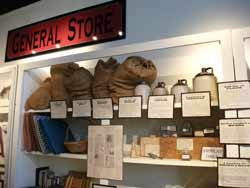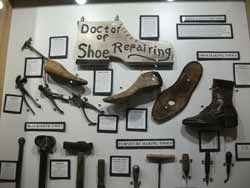
.jpg)
The pioneer past is literally at your fingertips at the End of the Oregon Trail Interpretive Center in Oregon City.
In the first of three buildings, you can see and touch many of the goods and supplies that pioneers might have chosen as they packed for the start of their months-long journey west. The replica provisioner's store, commonly called the "Missouri Room", starts you on your own journey through the Centers interpretive trail.
If you think you couldn't make the estimated 2,000-mile journey without your morning coffee, you're not alone! 5-10 lb of bulk coffee generally made its way to the wagon, saving lives by requiring coffee-lovers to boil their water. Everything had to be measured by weight (including the 6-lb coffee grinder), since the approximately 4 ft by 12 ft wagon could hold no more than 1,500 to 2,000 pounds.

This led to hard choices. A metal plow (40 lb) or a sewing machine (100 lb) might be tempting, but also bulky and heavy. Critical food supplies, including dried beef, bacon, beans, and a water barrel, could easily top 300 pounds. Even smaller items a Dutch oven (10 lb), an axe (7 lb), or a musical instrument (6 lb), all had to be considered by size and weight. The Missouri Room offers each visitor a two-sided "Packing Your Wagon" sheet listing almost 80 items and their weight. You decide what you'll take as you add up your total payload. Nearby, an empty wagon-sized wood box shows just how small your travel space might be.
Also in the Missouri Room are two vignettes showing what pioneers would leave behind. The first is a rustic home with woodstove, dining table, patterned china and a rocking chair. The second is a small schoolhouse, complete with reproduction Moore McGuffey's Readers and individual student chalkboards. Looking from one side of the Missouri Room to the other, you can feel both the ache of departure and the yearning for a new and better life.
One of the best parts of the Interpretive Center experience is the chance to explore pieces of the pioneers world first-hand. ("You can touch anything that isn't behind glass," the docent told me, smiling.) Feel free to open the McGuffey's Reader, to sit on a wooden barrel by a wooden checkerboard, or try on a pioneer-style hat. The full-size period dress even carries a sign reading, "Yes, it is OK to touch me." The pioneer past is literally close enough to touch.
The next building surprises the senses as visitors move to an intimate movie theater. As the room darkens, our eyes settle on the 3D scene of a broken-wheeled wagon. Around it, abandoned supply barrels, an ox skull and a small wooden grave marker are all cast in ghostly white. Behind them, we see two screens one literally a doorway into the past, and the other, a wide panoramic frame.
Soon, the white-haired image of Dr. John McLoughlin enters the doorway. Like a living holograph, he speaks to us in his authoritative but cordial tone, explaining his role in the Hudson Bay Company and his ties to the American pioneers. As he vanishes, the scene shifts to the larger screen and the long pioneer trail unfolds before us.
We follow this trail with the actual words of four pioneers - adventurer John Minto, wife and mother Elizabeth Dixon Smith, Barlow Road trailblazer Joel Palmer, and a sociable young schoolgirl, Lucy Henderson. Preserved in journals and letters, the words they wrote for themselves or shared with loved ones over 150 years ago are the exact words we hear again today as re-enactors illustrate their tales on the larger-than-life screen. Through frostbite and fiddle music, sudden death and a sisters birth, we follow their footsteps to the end of the Oregon Trail.
After emerging from the darkness of the theater, the third exhibit seems to stretch out in all directions. Marking the end of the Oregon Trail, it shows us how settlers spread out beyond their cramped covered wagons as they put down new roots in a new land.

One area highlights Oregon City's Land Office, where pioneers stopped to stake their claims after passage of the Donation Land Claim. Every male U.S. citizen over 18 could lay claim to 320 acres - with 320 more in his wife's name, totaling one square mile. Visitors can take their own reproduction land claims, describing their acreage in 1800s language "to have and to hold," as if in marriage.
Other areas focus on the trades and arts that flourished in this new population center. Tools of the time - from blacksmithing to shoemaking - are gathered on the walls, while fabric arts like quilting and tatting (lace-making) are laid out nearby. You can almost feel the productive energy that helped make Oregon City one of many "firsts" the first capital of the Oregon Territory, the first incorporated city west of the Rockies, and even the first Oregon town to host a lending library.
Additional areas show us the cultural artifacts of the indigenous Clackamas and Clowewalla peoples. Natural earth pigments in muted blues, greens, dark red and yellow are ready to be processed into paint. (Black charcoal would be used for tattoos.) You can touch an animal hide like the one stretched to make the drum displayed nearby. The zig zags, ribs and face-like patterns of the Columbia River art forms are explained near images of basalt stone carvings.
Learn more at historicoregoncity.org

GUEST WRITER: Beth Daniell is the Feature Writer for the Three Rivers Artist Guild (https://threeriversartistguild.com/). She also enjoys decorative painting, playing the fiddle, and exploring local pioneer history.